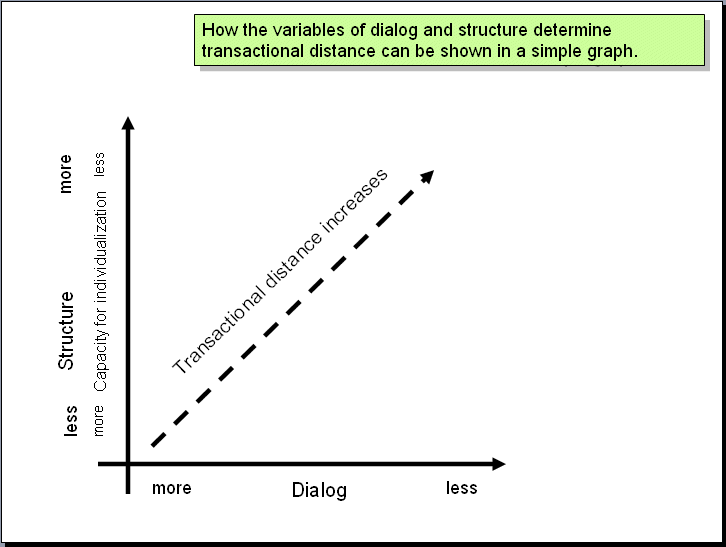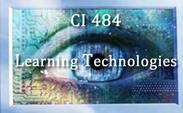Instructional Design Models, Theories & Methodology:
Moore's Theory of Transactional Distance
by Daniel Bornt (completed Aug. 22, 2011)
Moore’s Theory of Transactional Distance has a direct bearing on e-learning. It explains and quantifies the learning relationship between instructor and student in the e-learning situation, where there is a substantial physical or temporal distance between the two. First formulated in 1997, it considered the many different forms of distance learning as part of a group which could similarly analyzed.
Transactional distance - as distinguished from physical or temporal distance - refers to the psychological or communicative space that separates instructor from learner in the transaction between them, occurring in the structured or planned learning situation (Moore, 1997, p. 1).
In Moore’s theory, three clusters of variables control the extent of transactional distance: Dialogue, Structure, and Learner Autonomy. The following charts (EDEN, 2006) graphically portray these relationships.


Within these relationships, then, it can be seen that -
- By manipulating the communications media it is possible to increase dialogue between learners and their teachers, and thus reduce the transactional distance. (p. 2).
- When a program is highly structured and teacher-learner dialog is non-existent the transaction between learners and teachers is high. At the other extreme, there is low transactional distance in those teleconference programs that have much dialogue and little predetermined structure. (p. 3).

Learner autonomy is the third factor to consider in this process. “Learner autonomy is the extent to which in the teaching/learning relationship it is the learner rather than the teacher who determines the goals, the learning experiences, and the evaluation decisions of the learning program” (p. 6). The greater the transactional distance, the more autonomy the learner must exercise. Therefore, if it is recognized beforehand that the targeted learners have a predilection for autonomy, the course can be designed in that direction, e.g., it could be tightly structured with a minimum of dialogue, thus increasing transactional distance.

Moore’s theory was conceived on the cusp of the full-scale integration of the computer into society, which introduced an additional component into the mix: the enhanced teleconferencing abilities of the computer and Internet broadened the bilateral dialogic relationship that heretofore had just been between teacher and student, into a multilateral relationship which could include other students, as well (p. 7).
Moore's Theory Reconsidered
Yiannis Giossos (n.d.), in an analysis of Moore’s theory, reports that attempts to confirm it empirically did not meet with consensus. Nevertheless, as a major theory that informs the field of distance education, it is too valuable to discard despite its lack of complete empirical verification. One erroneous aspect of the theory, according to Giossos, is that Moore relied heavily on Dewey’s definition of transaction, but misinterpreted it. Moore defined transactional distance as “ ‘the psychological and communicative space’ between the teacher and learner” instead of Dewey’s definition of transactional distance as “the distance in understanding between teacher and learner” (para. 13). If Dewey’s definition is used instead, Moore’s theory can then be placed within the framework of realism, and thereby understood as an “open” scientific system without having to be proved empirically.
Although this might be seen as arcane hairsplitting among academics, it does have consequences. It means that Moore’s three clusters of variables that control the extent of transactional distance, viz., Dialogue, Structure, and Learner Autonomy, and the mathematical relationships he asserts exist between them, will not always be predictive. Giossos says that “In other words, the effort to show a steady relationship between the variables of transactional distance and structure cannot lead to any concrete result” (para. 16).The reason, of course, is that “[p]eople function in an open system which cannot be controlled” (para. 16).
Additionally, according to Giossos, “Within the context of realism, the objective is to prove the existence of hypothetical mechanisms and not to find predictable regularities....a phenomenon can be explained, but this does not necessarily means that it can be predicted since in open systems, such as in society and education, the complexity of the involved structures makes prediction impossible” (para. 19).
From a general observational standpoint, I personally find Moore’s theory an excellent working model to understand distance learning. It doesn’t matter that the variables don’t exactly predict the transactional “distance.” What counts is that it provides a metric for understanding how transactional distance occurs, and what proactive steps can be taken in order to reduce it.
Moore’s theory bears little relation to the other theories discussed and explained on this Wiki. Its main concern is to understand what are the factors that produce the communication gap between teacher and learner within the distance learning situation, while the other theories are directed toward different approaches toward the learning process itself.
References:
Moore, M. (1997). Theory of Transactional Distance. In Keegan, D. (1997). (Ed.). Theoretical Principles of Distance Education. Routledge, pp. 22-38. Retrieved 28 July 2011.
http://www.aged.tamu.edu/research/readings/Distance/1997MooreTransDistance.pdf
European Distance and E-Learning Network (EDEN). (2006). Theory and theorists: Michael G. Moore. Evolution of Theory of Transactional Distance
http://www.eden-online.org Powerpoint presentation retrieved 28 July 2011 from Google search
Giossos, Y. (n.d.). Reconsidering Moore’s Transactional Distance Theory. European Journal of Open, Distance, and E-learning (EDEN). Retrieved August 20, 2011. http://www.eurodl.org/?article=374
